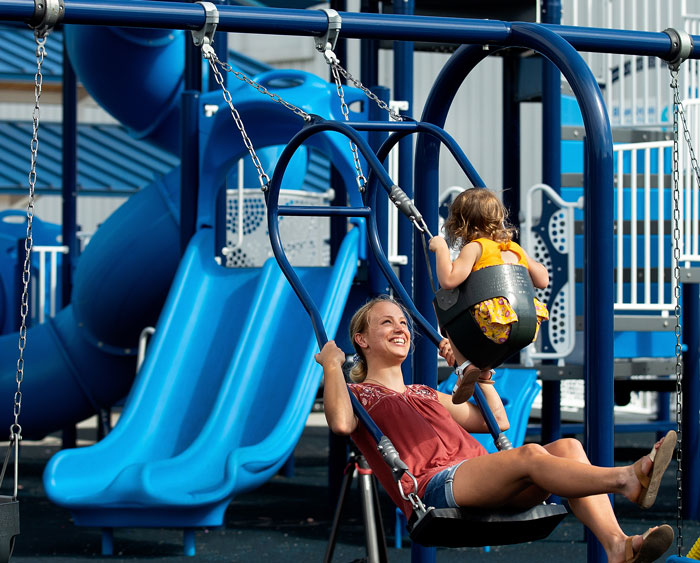It’s not too hard to think back to childhood and remember the allure and thrill of risk-taking when you were at play—climbing higher, spinning faster, jumping farther. But what we didn’t know then was that the so-called risky play we endeavored in was actually helping us to develop social, emotional, physical and cognitive skills, even if it caused the occasional bumps or scrapes.
Research shows us that outdoor free play can provide many valuable developmental benefits. The nonprofit International Play Equipment Manufacturers Association (IPEMA) thinks of playgrounds as nature’s “hands-on classrooms that provide tremendous learning opportunities to kids of all ages.” They see play as an essential tool in a child’s development. “From teaching problem-solving to understanding how to self-assess risks, learning to take risks is an important part of development, and play at playgrounds can play a big role in that,” said Brad Pittam, president of IPEMA.
Balancing Safety & Risk
Part of the IPEMA mission is to “promote play and encourage safety,” but just how do those in the business of play strike that balance between promoting risky play while also working to protect kids from injury? “The key is to create an environment where children can take risks more safely and help mitigate risk to serious injury wherever possible,” said Pittam. “Fall risk, for example, is something we’re always mindful of when thinking about play equipment. That’s why it’s important to not only select the right materials, but to make sure equipment height and the depth of loose-fill material is up to code.”
IPEMA provides a third-party product certification program for public play equipment, and Pittam stressed that it’s also important to use certified installers wherever possible to balance safety and risk at the playground. “The third-party product certification of playground equipment offers an independent review of products—including both equipment and surfacing—and delivers proof of credibility and quality assurance to customers. Third-party certification also increases brand trust, which is why we always recommend looking for IPEMA-certified equipment, which ensures that products conform and comply to certain ASTM (formerly American Society for Test and Materials) and CSA (Canadian Standards Association) standards.”
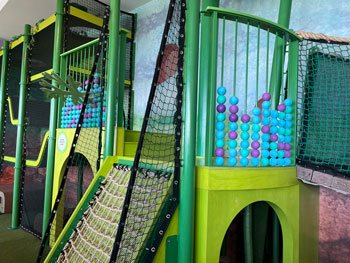
Randy Watermiller, vice president of product development for a Delano, Minnesota-based designer and manufacturer of playground equipment, said playgrounds should keep kids away from dangerous hazards while encouraging them to test their limits, learn to overcome challenges and take healthy risks. “We consider risky play to be essential to the development of children. However, the balance to that is removing hazards. Our playground designs include age- and developmentally-appropriate challenges so that kids receive a variety of play experiences, which helps them develop skills needed for the next phase of life.”
“A well-designed playground includes both challenging equipment and a safe and controlled environment for a child to test, assess and explore,” continued Watermiller, who explained that the playground’s layout is important when it comes to safety. “The CPSC (Consumer Product Safety Commission) Public Playground Safety Handbook suggests that age groups be separated to help reduce the chance of injury from older, more active children running through areas filled with younger children and generally slower movement and reaction times.”
He said it’s important to work with customers to gain their perspective on potential users of the site. “Their knowledge of the community will help determine what types of age- and developmentally-appropriate challenges would be suitable for their particular environment.”
Pittam agreed that a quality playground should be made up of separate areas with appropriately-sized equipment to cater to different age groups. “That way, you don’t have much-older children inadvertently trampling on younger children who require different accommodations.”
He said signs posted in the area or on the equipment can give guidance, but the appropriate age group should be rather obvious from the design, layout and scale of the equipment. “During the design phase it’s also important to consider the natural flow of the playground; as children come off the swings, where will they head next? Make sure there’s always something interesting within their eyesight as they come from one piece of equipment and head to another.”
Playground equipment continues to become more spectacular these days, oftentimes even resembling giant pieces of playful art. “What many of us remember as ‘jungle gyms’ or ‘monkey bars’ have been replaced with innovative composite play systems, complex net and rock climbers and play systems rooted in educational exploration,” said Pittam. “We’re definitely seeing a fantastic trend of manufacturers creating thrilling, taller structures that generate excitement in children, all the while being in a safe, IPEMA-certified play environment. In these environments, a child feels like they’re taking a risk and being daring—challenging themselves—and manufacturers are doing a terrific job of creating that space in a safer way.”
Watermiller said they’re committed to designing to meet a wide variety of playground standards to ensure that their playground equipment products are safe for children. “We often bring kids in to observe how they’re playing on the new equipment. We watch to see how they’re using—or misusing—the new product, and then evaluate and reassess how we might be able to improve it for better safety.”
What’s Under Foot?
Playground spills and falls are responsible for around three-quarters of playground injuries. Gone are the days of concrete, asphalt, dirt and grass surfaces, and by selecting a quality surfacing material, you can help mitigate some of the risk associated with serious trips and falls, according to Pittam. “Critical fall height is incredibly important to consider when building a playground, and your surfacing material plays a vital role in that. Some major factors to consider include budget, chosen playground equipment, location of the playground, maintenance needs and more. Surfacing options are abundant in the current industry landscape, so there are plenty to choose from to best meet the specific needs of the playground.”
While sand and pea gravel are still utilized, other recommended loose-fill surfaces include engineered wood fiber (EWF) and rubber mulch, while unitary surfaces include poured-in-place rubber (PIP), bond-in-place rubber, interlocking tiles and artificial turf. “Each of these surfaces have a unique set of benefits,” said Pittam, “from impact attenuation and creative design to easy maintenance and budget friendliness.”
Chris Wolf is general manager of a Corona, Calif.-based safety surfacing manufacturer that offers options for PIP surfacing. Wolf explained how their “workhouse” option uses a mix of 1- to 4-millimeter TPV granules, high-quality polyurethane and an SBR impact attenuation layer. He said that in addition to being high-quality and durable, the PIP systems are “intrinsically suited for ADA compliance. In fact, much of the early PIP industry in the 1980s-90s was just that—providing reliable ADA access and pathways to otherwise partially accessible playgrounds of loose materials.”
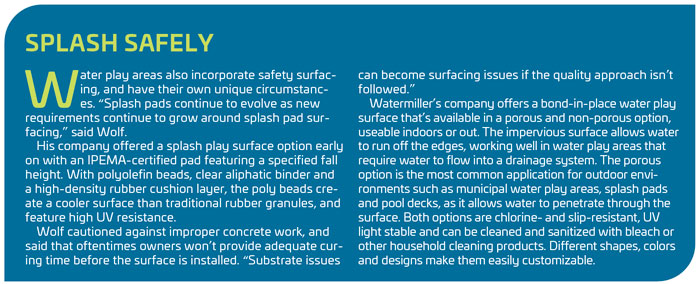
From there, PIP surfaces took off, according to Wolf, as owners came to appreciate the clean, safe and fun impact-attenuating surfaces provided by modern systems. And now, owners regularly budget for entire playgrounds of PIP safety surfacing. Color and design options are numerous. “Additionally, city and school district risk managers appreciate the reliability of PIP surfacing compared to loose fill that might require a maintenance person to rake it out daily, to provide safety and impact attenuation from low spots becoming wallowed out, causing owner liability.”
Wolf explained that PIP systems are low-maintenance, typically requiring just a monthly inspection. He said power washing helps with gum or tree sap, and pads can always be repaired or modified easily using manufacturer-provided materials.
“Long-term maintenance can include a special polyurethane roll coat, applied three to five years after installation. Generally, roll coats improve the life span of surfacing by locking in loose granules and can refresh the surface appearance.” He said some in the industry might suggest you roll-coat pads every couple years. “I’d suggest you take a more measured approach and evaluate the pad every few years to see if it might benefit from this.” Overdoing it can affect the porosity of the pad.
Synthetic turf is another option for mid-range budgets. It maintains cooler surface temperatures and also comes in a variety of colors and densities. Wolf explained that some systems have an infill of rubber granules, while their adhered playground system contains no granules, offering complete containment of the system. “No loose granules in kids’ socks, eye debris or ingestion worries. Also, there is not subsequent migration of rubber granules onto adjacent sidewalks or into city drains and sewer systems and into the public waterways and oceans, an important consideration for any municipality or school district.”
Resilient rubber tiles are another unitary surface option, which can either be interlocking or adhesive. Commonly used in high-wear areas, they can provide a critical fall height value and require little maintenance. They’re easily replaceable and come in a variety of colors.
Finally, loose fill materials are easy to install and have the least expensive upfront costs. They shift and move on impact, helping to protect from long-bone injuries. However, they require more maintenance to maintain the appropriate depth under CPSC guidelines, and they’re less accessible.
Some plans incorporate multiple surfacing types into a single site, for example, rubber tiles around high-traffic areas like slides and access points and EWF placed under decks and adjacent open spaces.
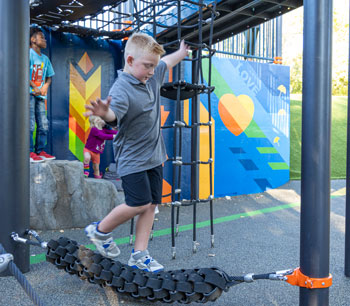
In the 2018 ParkScore report released by the Trust for Public Land (TPL), which rates the top 100 cities in the U.S. in various categories, Lincoln, Neb., earned the No. 5 spot in the playground category, with 4.6 playgrounds for every 10,000 residents. J.J. Yost is the planning and facilities manager for Lincoln Parks and Recreation, and he said the majority of their playgrounds utilize rubber tile surfacing with sand and gravel in swing bay areas. “The tiles lend themselves to relatively easy removal and replacement when needed and require minimal maintenance over the lifespan of the tile.”
He said in most applications they do an annual tiling and raking. “More (loose fill) product is added when needed, and typically we can go several years without adding.”
Installs are usually done in-house, and while they don’t power wash the surfaces often, the need does occasionally arise. “You need to keep the pressure down so as not to harm the surface of the tile.”
Yost said impact attenuation testing has been conducted on surfaces by equipment manufacturer representatives, occurring when staff had concerns with the condition or integrity of the tile or when evaluating conditions for future maintenance activities. Pittam said this testing is important, especially in high-traffic areas. But Wolf cautioned that owners had better be prepared to take action and be properly budgeted if there are issues, since playgrounds may need to be shut down, fenced off and have surface systems replaced.
Time for Inspection
Playgrounds in Lincoln are inspected weekly by park district staff, according to Yost. “Inspections should look for swing chain wear, loose fasteners, damaged slides, surfacing defects, etc.”
Maintenance and repairs are typically completed by parks staff, though third-party contractors have been used. And he said the parks department has initiated some employees to become Certified Playground Safety Inspectors (CPSI).
Watermiller pointed out that some playgrounds may require daily inspections while others may be monthly. “The most common factors to determine the frequency include the type of protective surfacing such as sand or other loose-fill material, equipment that has moving parts, playgrounds that have high use or are used by older children, areas more subject to vandalism, the types of materials used to construct the playground and environmental factors like exposure to salty air near a coast or a desert sun.” He said they provide guidance to customers on how to establish a maintenance program and also provide a maintenance kit with the purchase of each new play structure.
Pittam said to look for obvious issues like cracking and warps in equipment. “Any breakage, loose or sharp ends should be immediately rectified. Keep an eye out for paint damage, loose hardware or rust.” He pointed out that while facilities typically inspect their own playgrounds for wear and tear, some bring in third parties to conduct inspections annually or semi-annually.
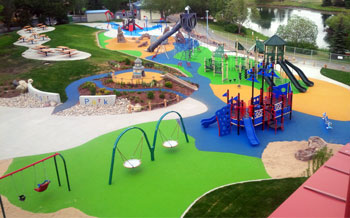
Amy Hill is director of the Injury Free Coalition for Kids of Chicago, a program through the Ann & Robert H. Lurie Children’s Hospital of Chicago. One of their missions over 25-plus years has been advocating for safe playgrounds and building playgrounds citywide. In 2018 they built their 20th playground. Previous to that they partnered with a local advocacy group to survey all 450 of the Chicago Park District’s playgrounds and provide safety evaluations.
“We used the report card developed by the National Program for Playground Safety (NPPS), using their SAFE method: Supervision, Age-appropriate equipment, Fall surfacing, Equipment maintenance,” said Hill, who is a CPSI. She said they used a team of college students to visit each playground and assess its safety, issuing a report at the conclusion of each summer and grading each playground. “If our team saw issues that required immediate maintenance, we alerted the park district. They gave us permission to visit each site and met with us to review our annual report.”
Playgrounds scored poorest in fall surfacing and equipment maintenance. Failing playgrounds were re-surveyed the following year, with the mean playground score among failing playgrounds improving significantly.
When it came to refurbishing sites, Hill said they sometimes added additional equipment, particularly age-appropriate equipment for children aged 2 to 5. Sometimes they updated the playground’s surface. “We worked with rubber tiles, poured-in-place rubber and engineered wood fiber. The surfaces weren’t really outdated, but EWF surfaces were often lacking appropriate depth.”
The playground surveys showed that many failing playgrounds could be brought up to standards with improvements in fall surfacing and equipment maintenance. “The Chicago Park District sometimes used a playground’s grade as one of the criteria to fund and build a new playground,” said Hill.
She said partners in other cities have also built playgrounds. “The Harlem Injury Free Coalition for Kids in New York City was responsible for building many playgrounds.”
When it comes to playground safety tips, Watermiller mentioned ASTM F1487 as a great resource for equipment manufacturers, designers and others requiring more technical information. And he described the CPSC Public Playground Safety Handbook as a good resource for the general public. Pittam mentioned their ongoing initiative, Voice of Play, as a great consumer-friendly playground resource, and said they’re proud of their affiliations with outside organizations. “We want our playgrounds to be safer, fun areas for people to gather and enjoy, so the organizations and manufacturers we work with are extremely important for our safety mission.” RM



